There's never been a culture more visual than ours, and it's going to get worse. Since the advent of phones able to take pictures (less than 20 years ago) there's been an explosion of images. According to InfoTrend, the world will take 1.2 trillion photos in 2016. Most of them will sit on our phones until we delete them without ever having looked at them again. Why do we do it? Is it literally to "capture" a moment, to increase our possessions by making the intangible tangible and claiming it for our own? And what is our obsession about documenting every moment doing to our sense of time, values and even friendship, if we can't just enjoy without clicking?
These rather gloomy thoughts were prompted by the resurfacing on social media of an image of Jesus from a couple of years ago. Unlike the usual airbrushed Aryan look, this claims to be the real deal. Retired medical artist Richard Neave used skulls from the Jerusalem area to reconstruct a typical 1st-century Semitic face. Of course the chances are millions to one against it really being the face of Jesus, but the reconstruction narrows the field a bit; he was more likely to be short, with brown eyes and dark curly hair, than the chap who's knocking on the door in that Light of the World painting.

But you know what? I don't care. I don't think it matters what Jesus looked like, and I'm not even mildly curious. I think that rather than obsessing about image, we should care about content. What someone looks like is far less important than what they say, and what they say is far less important than what they do. And I wonder what, in this image-obsessed age, people would have made of someone who was nothing special to look at?
What's quite interesting on the other hand, is the way that – in the absence of any evidence whatever – people have spun his suppose appearance. Many early accounts of what he looked like focused on what they said was his unattractiveness. The 2nd-century anti-Christian philosopher Celsus described him as "ugly and small". He could be written off as biased, but Christian authors concurred: Irenaeus said he was "weak and inglorious", other early sources say he was small bald and 'crooked' or hunch-backed (The Acts of John). They point to Isaiah's prophecy that he had no beauty or majesty to attract us to him" (53:2). Some have even suggested that the taunt, "Physician, heal yourself" (Luke 4:23) was a reference to some bodily deformity – unlikely, as it's never mentioned in the Gospels and it would have been difficult for him to have gained such a following if he were deformed in some way.
That was not, however, the image that prevailed. more mainstream figures like St Jerome and St Augustine said he was an ideal specimen of human beauty, and that – unsurprisingly – is the version that came to dominate in figurative art.
I suspect that they're both wrong, and that Jesus was just ordinary. And I think, too, that it's just as well we don't know what he looked like. I think this is one of the rare areas where it's OK to detach the historical Jesus from his roots in a particular place, in the interests of universalising him. My own tradition is Baptist, and we don't do pictures of Christ. But I like the idea of an African Christ who is black. I like the idea of a recognisably Chinese Christ, or an Inuit or Malay Christ; even of a white Christ. Because once we capture an image of Christ and say, "This is who he is," we're also saying, "This is who he is not." And we mustn't do that, because Christ is not just for one people, but for the world.
There's only one answer to the question, "What did Jesus look like?"
He looked like me. And you.
Follow Mark Woods on Twitter: @RevMarkWoods













